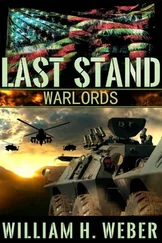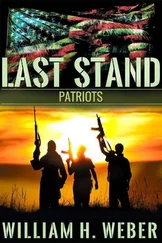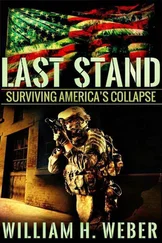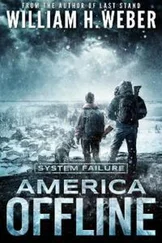On one side of the interstate stood a row of houses. On the other were industrial buildings with low, flat rooftops. Both offered the perfect place from which to set up an ambush. General Brooks came over the walkie on a channel reserved for commanders. “I want all of these buildings swept and cleared and defensive positions established within the hour. When those Chinese columns come rolling down the 81 looking for an escape route, I wanna make sure they get the greeting they deserve.”
John and Moss shared a nervous glance. So far things were going smoothly. Maybe a little too smoothly.
•••
Since the retreating Chinese would be coming at them from east to west, the defensive lines were set up in a series of kill zones. Artillery and mortar teams on either side of the interstate zeroed in on both of the approaches. The 155mm howitzers would be loaded with DPICMs—Dual-Purpose Improved Conventional Munitions—an artillery shell loaded with smaller bomblets, each capable of taking out a tank. When the shell reached a specific altitude, it would explode, releasing the smaller submunitions. In addition, IEDs littered the northern and southern edges of the highway. Once the enemy got close, the detonations would isolate the tip where the Americans would get to work destroying them piecemeal.
As in Oneida, the second story of homes became small fortresses unto themselves. Additional fire teams took position on the flat roofs of the industrial buildings on the southern side of the highway. They’d also brought what remained of the AT-4s, Javelin anti-tank missiles and Stinger surface-to-air shoulder-fired rockets. The latter was merely a precaution, for although the Chinese jets were likely shielded from the effects of the recent EMP, the supplies and replacement parts required to keep them in active service were not. This was why the skies over Oneida had been largely quiet and peaceful following the mission, save for Billy Ray’s occasional barrel roll whenever he returned from a successful leaflet drop.
Banks of earth and sand piled up along the north and south edges of the highway had originally been designed to cut down some of the traffic noise, but the formation had inadvertently given the American forces a nice reverse slope they could use for defense. Rather than silhouetting themselves along the crest, a reverse slope defense allowed units to remain largely hidden from sight and protected from direct fire. Even indirect fire was blind since spotters couldn’t observe the effects of the exploding shells.
In reserve, General Brooks kept a mix of his most experienced men, along with a couple hundred of his greener troops. Among the latter were Gregory and Brandon. For his part, John and his Rough Riders were also kept in reserve on the southern side of Interstate 81. The speed with which they could deploy allowed them to act as a quick reaction force, ready to apply fire wherever needed.
With everyone in position came arguably the most challenging part of any mission—waiting for the enemy to approach. If the situation at the front went well, then the retreating units heading their way would largely be shredded versions of their former selves.
John called Reese on the walkie. The sniper was perched in the tower of a nearby church. “You see anything?”
“No, sir. Just a long, boring stretch of highway in both directions. It’s enough to get a man thinking. Once we’re done with this mess, I’m gonna get me one of those motorhomes and head west.”
John laughed. “Who knows, maybe Moss will join you.”
“Oh, no, Colonel. I’m a lone wolf. Besides, I have some unfinished business out that way I’ve been itching to take care of.”
“All right,” John said. “Keep ’em peeled and lemme know as soon as you see anything.”
“Roger that.”
When they were quiet, they could hear the dim echo of distant battle.
“Sounds intense,” Moss said, removing his magazine and blowing away imaginary dirt. “If it sounds this bad here, what’s it like over there?” He paused and reinserted the magazine into his M-4. “You think this crazy plan of yours will work?”
John shrugged. “It’s Brooks’ plan now, not mine. And I hope so.” He couldn’t help thinking of Brandon and Gregory at that moment, both part of the reserve infantry formation, tasked with plugging holes and deploying wherever they were needed on the battlefield. Hopefully their nerves weren’t getting the better of them.
John got on the walkie to Rodriguez. “Any update from the front?”
After a small delay, Rodriguez replied, “American forces are pulling back as planned, but they’re taking far more casualties than expected. The NATO force is still waiting to head into action, but they describe the situation right now as touch and go.”
“That ain’t good,” Moss said with his usual talent for summing up a situation in three words or less.
A minute later Reese was back on the horn. “I got incoming.”
John lifted the binoculars and scanned east along Interstate 81. There wasn’t a soul in sight.
“You sure about that? I’m not seeing anything from where I am.”
“Not east,” Reese said, his voice betraying a slight tremble. “They’re coming from the north, down Interstate 26. At least battalion strength—no, make that a division—and these guys aren’t the Chinese.”
John swung in the other direction and felt the blood drain from his face as he saw what Reese had meant. “God help us.”
“I don’t like the sound of that,” Moss said, scrambling for a better look. “What do you see, John?”
John lowered the binoculars, his mouth suddenly bone dry. “The Russians are coming.”
The forward edge of the enemy advance was still about two miles north of where the interstates met when John radioed General Brooks and told him what was coming. Their own artillery was recessed a few miles from the front lines and could be called on at any time.
“An entire division?” Brooks asked. “Are you certain?” He’d been anxious to whip the retreating Chinese not long ago but he suddenly didn’t sound so sure anymore.
“Positive,” John said. “When you notify General Dempsey, tell him to send whatever support he can.”
Brooks scoffed at the idea. The chances were slim the Americans along the main line had much help to offer. “Tell your men to stay hidden,” the general advised him. “We’ve still got the element of surprise on our side.”
A second later, the order went out. They would wait for the Russians to be drawn in before they sprang the trap.
Benson was next to John on the industrial roof and he racked his M249 and smiled. “Think we’ll make it out of this one, Colonel?”
The corner of John’s mouth turned up in a half-hearted grin. “Of course we will,” he lied.
The others around them stayed low, prepared to spring when the signal was given.
Unexpectedly from the north came the telltale whoop of approaching helicopters.
“Reese, that what I think it is?”
The moments of silence ticked by with painful slowness. “Yes, sir,” came the reply. “We got half a dozen Havocs closing fast.”
Havoc was the NATO designation for the Russian Mil Mi-28 attack helicopter. An upgrade from the troop-carrying Hind made popular in so many movies, the Havoc looked more like the Apache and was just as deadly.
John switched channels, alerting the Stinger teams. The Americans’ cover was about to be blown one way or another. It wasn’t uncommon for ground forces to send air assets to scout ahead in order to avoid the very type of ambush awaiting them now.
John swore under his breath. They hadn’t fired a single shot and already they were in serious trouble.
Читать дальше












